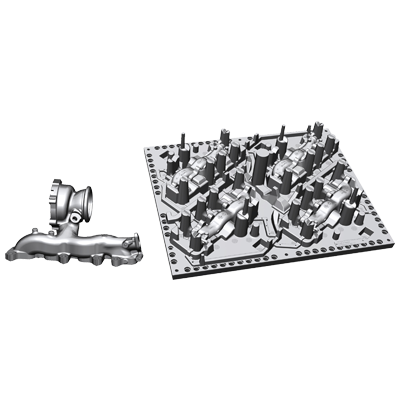The quality and productivity of die-casting parts depend to a large extent on whether the heat balance control of the die-casting mold is correct. Only by effectively controlling and adjusting the heat balance of the die-casting mold can the die-casting process parameters be stabilized.
In die-casting production, when the heat dissipated by the mold is greater than the heat input from the alloy liquid to the mold, for example, when a larger mold is used to die-cast thin-walled parts or a mold with more slider structures, in order to achieve the thermal balance of the mold, it is necessary to add. Add heat to the mold; the method of adding additional heat can be solved by using a mold temperature control machine, placing an adjustable tubular electric heater on the mold, placing an insulator outside the mold, or setting the excess part of the casting including the overflow groove. On the contrary, the heat input by the mold is greater than the heat output by the dissipation, and the mold temperature exceeds the specification, and artificial forced cooling must be used.
For each die-casting cycle, the mold absorbs the input heat from the alloy liquid and dissipates the heat to the outside through heat conduction. Generally, radiation and natural convection only lose 5% of the total input heat, and the remaining 95% is completely absorbed by the mold. Heat conduction output. When the heat absorption and heat dissipation of the mold is equal in unit time, the equilibrium state can be achieved, that is, the mold reaches thermal equilibrium so that the heat input to the mold must be equal to the sum of the heat output through natural dissipation and artificial cooling so that in each die casting cycle The heat input and output of the mold are the same.
In actual production, there are many factors that affect the heat balance of the mold, including pouring temperature, mold preheating temperature, the capacity of alloy liquid, mold volume, location and quantity of pouring overflow system, mold cooling condition, and operation cycle time, etc. To achieve a good heat balance of the mold, it must be achieved through the adjustment of the die casting process parameters, including the injection pressure, punch speed, mold retention and ejection time, spraying, and other factors that affect and restrict each other.
The selection and adjustment of the mold temperature should be comprehensively considered according to the shape, size, and structural characteristics of the casting, as well as the properties of the alloy, mold structure, and pouring conditions. The recommended working temperature of the die-casting mold is as follows: Alloy 180-240℃, aluminum alloy 200-250℃, copper alloy 280-350℃.
Effectively controlling and adjusting the mold temperature can not only prolong the life of the die-casting mold but also is a key process parameter to ensure good filling of the alloy liquid and stable casting quality. At present, the die-casting workshops that have requirements on the quality of die-casting parts without corresponding means of controlling the mold temperature basically require that the molds be preheated before production to avoid excessive cooling of the alloy liquid and sudden increase of the mold temperature gradient, which will reduce the quality of the castings and the overheating. If the mold is damaged early, the temperature of the key parts of the mold should be checked and adjusted according to the process regulations, the production rhythm and the pouring flow of the alloy liquid, and the adjustment of the spraying should be controlled.




 Pусский
Pусский Español
Español













